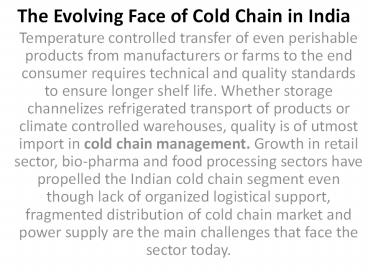Cold Storage,Cold Chain Industry in India - PowerPoint PPT Presentation
Title:
Cold Storage,Cold Chain Industry in India
Description:
Gati kausar Cold Chain India – Refrigerated Storage, Logistics Solutions, Warehousing and Logistics, Refrigerated Transportation – PowerPoint PPT presentation
Number of Views:2481
Title: Cold Storage,Cold Chain Industry in India
1
The Evolving Face of Cold Chain in India
- Temperature controlled transfer of even
perishable products from manufacturers or farms
to the end consumer requires technical and
quality standards to ensure longer shelf life.
Whether storage channelizes refrigerated
transport of products or climate controlled
warehouses, quality is of utmost import in cold
chain management. Growth in retail sector,
bio-pharma and food processing sectors have
propelled the Indian cold chain segment even
though lack of organized logistical support,
fragmented distribution of cold chain market and
power supply are the main challenges that face
the sector today.
2
The top five sectors dominating the Indian retail
market are fresh and processed foods, fashion and
fashion accessories, leisure-based products and
consumer durables. Dairy products, fruits and
vegetables, meat and poultry, fisheries, packaged
foods and beverages comprise foods sector which
covers the cold chain largesse. However, uneven
capacity distribution along with capital
intensive market with high operational costs
dissuades the growth of organized cold chain
logistics in India. Apart from foods sector,
integrated cold chain is necessary for enhancing
the qualitative shelf life of products such as
photographic film, chemicals, vaccines, serums
and pharmaceuticals drugs. The varied products
dictate the use of advanced technology to
preserve and protect the inherent product
attributes thus including not only refrigeration
but also air quality levels i.e. oxygen,
humidity, CO2 etc and other environment factors
making cold chain solutions a challenging sector
to manage and operate.
3
Cold chain requires proper coordination between
staff, equipment and material in order to avoid
the following bottlenecks Breakdown in cold
chain due to lack of fuel, transportation, spare
parts etc Lack of planning Inadequacies in
maintenance Incorrect use of technology Lack
of management in case of emergencies such as
natural disasters, epidemics etc.
4
In order to tackle and solve these bottlenecks in
cold chain logistics and for risk management, the
following three steps are important
5
Inefficient cold chain affects local markets or
farmers adversely since sometimes they do not
have the infrastructure, capital or technical
knowledge for preservation of their produce.
Misaligned warehouses and transportation for
temperature sensitive goods adds to their woes.
Bringing farmers closer to fresh and safe
agricultural produce is Gati Kausar, Gatis
subsidiary, that enables seamless accessibility
of integrated logistical support over long
distances and wider consumer base thus helping
them reach out to countrywide buyers with minimum
wastage. In a nutshell, the cold chain solutions
segment is a continually evolving sector that has
the potential to grow if approached in an aligned
manner eliminating occurrences of fragmented
channels.































